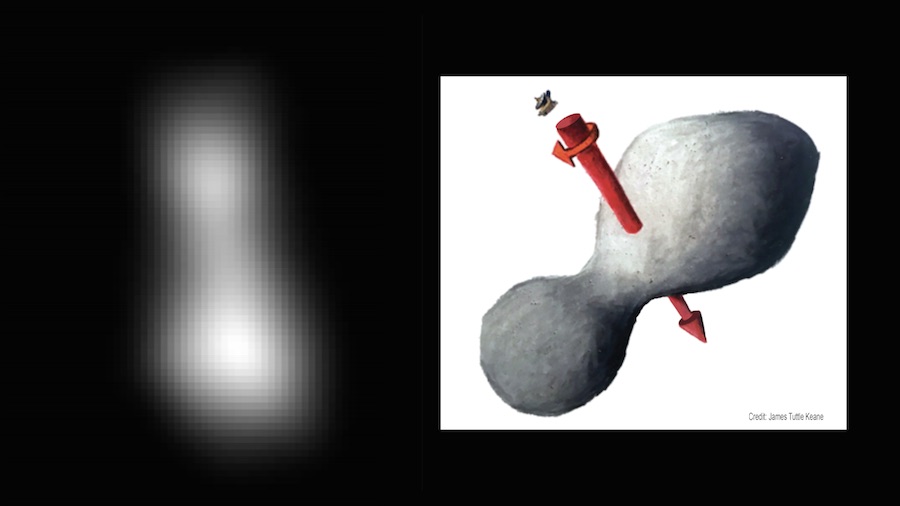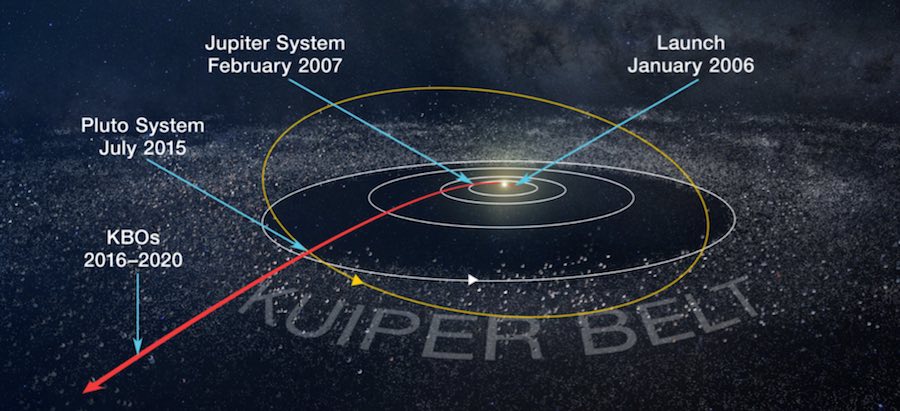
A fresh image from NASA’s New Horizons spacecraft released Tuesday showed the mission’s distant flyby target a billion miles beyond Pluto — nicknamed Ultima Thule — has an elongated shape like that of a peanut shell or a bowling pin, and the prospect of higher-resolution pictures arriving on Earth later in the day had scientists salivating for more.
“I don’t know about all of you, but I’m really liking this 2019 thing so far,” said Alan Stern, the New Horizons mission’s principal investigator from the Southwest Research Institute. “We’re here to tell you that last night, overnight, the United States spacecraft New Horizons conducted the farthest exploration in the history of humankind, and did so spectacularly. Thousands of operations on board the spacecraft had to work correctly in order for us to be able to tell you this, and now we know that it all did.”
New Horizons phoned home hours after its encounter with Ultima Thule, and the ground team at the Johns Hopkins University Applied Physics Laboratory here confirmed the first signals from the probe since the flyby arrived on Earth at 1531 GMT Tuesday.
Subsystems aboard New Horizons looked good at first check, including the probe’s solid state recorders, indicating the spacecraft gathered the data intended during the flyby of Ultima Thule, the most distant planetary body ever explored up-close by a space mission.
“We have a healthy spacecraft, we’ve just accomplished the most distant flyby,” said Alice Bowman, mission operations manager, known by the acronym MOM.
An hour later, scientists gathered in a press conference to present a new image of Ultima Thule.
Stern joked that it’s “OK to laugh” at the blurry image released Tuesday, which was the sharpest view the spacecraft’s Long-Range Reconnaissance Imager, or LORRI, black-and-white camera obtained of Ultima Thule before zipping past the object at a velocity of more than 14 kilometres per second (32,000 mph) at 0533 GMT New Year’s Day.
“But it’s better than the one we had yesterday,” Stern told an auditorium of scientists, reporters and space enthusiasts gathered at the Johns Hopkins University Applied Physics Laboratory, where the New Horizons spacecraft was built and home to the mission control center.
“In my line of work, we like to interpret even images like this. … First, we have a better handle on the size of Ultima, it’s about 35 by 15 kilometres (21 miles by 9 miles),” Stern said. “Secondly, you see its irregular shape. There are two possibilities here. One possibility is that it’s bilobate with the upper lobe being smaller than the lower lobe, so they would be asymmetric. Or it may be these are two things that are actually in orbit around each other and just blurred together because of their proximity. Tomorrow, we will know which of those is the case.”
Scientists have already been able to solve one mystery about Ultima Thule, which has an official name of 2014 MU69, designating its discovery by astronomers using the Hubble Space Telescope in 2014.
“Ultima is finally revealing its secrets to us,” said Hal Weaver, New Horizons project scientist at APL. “Even though it’s a pixelated blob still, it’s a better pixelated blob than the day before. In fact, these images have allowed us to resolve something that was really puzzling to the scientists.”
The axis of Ultima Thule’s rotation appears to be pointing roughly toward the direction of the New Horizons spacecraft’s approach, giving it the appearance of spinning like a propeller. That would explain why scientists did not see any significant change in Ultima Thule’s brightness as New Horizons homed in on the distant, icy world, which kept the team from determining its rotation rate.

Before Tuesday’s flyby with New Horizons, scientists were uncertain whether Ultima Thule was actually one object, or perhaps two bodies orbiting in close proximity to one another. The latest image suggests it is more likely a single body, but scientists still did not rule out the binary explanation for Ultima Thule’s appearance.
“My bet would be it’s probably a single object, it’s bilobate, and if I’m wrong I’ll tell you tomorrow,” Stern said. “If it’s two separate objects, this would be an unprecedented situation in terms of how close they’re orbiting to one another. it would be spectacular to see, and I’d love to see it, but I think the higher probability is it’s a single body.”
Better images from the New Horizons spacecraft’s LORRI camera should be received by NASA’s Deep Space Network antennas beginning around 2000 GMT Tuesday. That communications downlink from New Horizons is expected to last until 2335 GMT, according to Bowman, followed by another window to receive signals at 0400 GMT Wednesday.
The transmissions will take roughly 6 hours and 8 minutes to travel the vast distance between New Horizons and Earth at light speed — 300,000 kilometres per second (186,000 miles per second).
The probe’s 15-watt transmitters can beam data down to scientists at 500 to 1,000 bits per second, so it will take 20 months to get all the data and imagery to the ground. The downlink will be interrupted from 4 January until mid-January because New Horizons — located in the constellation Sagittarius as seen from Earth — will be too close to the Sun in the sky for reliable communications.
“This mission has always ben about delayed gratification,” Stern said. “It took us 12 years to sell it (to NASA). It took us five years to build it, and it took us nine years just to get to the first target.”
Ultima Thule is part of the Kuiper Belt, a “third zone” of the Solar System beyond the inner and outer planets, and New Horizons is the first space mission to visit objects residing so far from the sun, following its 2015 first-ever encounter with Pluto and this week’s flyby of Ultima Thule. Ultima Thule takes 298 years to complete one orbit around the sun, and scientists believe it has been in the same region of the solar system since the formation of the planets 4.5 billion years ago.

“There are really two attributes of Ultima Thule that make it so scientifically valuable for us,” Stern said.
“First, because it’s so far from the Sun, and the sunlight is so weak out there that the temperatures are down near absolute zero,” he said. “As a result of that, chemical reactions are essentially frozen, so the object is in such a deep freeze thats it’s perfectly preserved from its original formation.
“When you combine that deep freeze with the fact that Ultima is a small body, only tens of kilometres across, it can’t have a strong geologic engine like Pluto, for example, which is also cold but you could see the activity on its surface and (in) its atmosphere. Ultima doesn’t have the ability to evolve that way.
“So everything we’re going to learn about Ultima, from its composition, to its geology, to how it was orginally assembled, whether it has satellites and an atmosphere, and those kinds of things, are going to teach us about the original formation conditions of objects in the Solar System,” Stern said. “All the other things that we’ve gone out and orbited and flown by and landed on can’t tell us because they’re either large and they evolved, or they’re warm, and they evolved for that reason. Ultima is completely unique.”
Email the author.
Follow Stephen Clark on Twitter: @StephenClark1.
